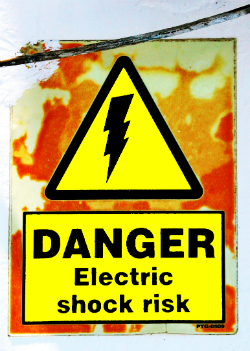Training Spotlight: Electrical Safety
Training programs must help technicians identify and prevent workplace hazards
Maintenance and engineering technicians can come into contact with uncontrolled electricity as they work on or near energized equipment. Regardless of their involvement with electricity, they need proper training that teaches them ways to identify and evaluate electrical hazards and demonstrates strategies for controlling recognized hazards.
A range of safety issues also affect employees engaged with electrical work, and managers must integrate these issues into electrical-safety training programs.
OSHA Requirements
Electricity has long been recognized as a serious workplace hazard, and federal regulations and training requirements apply to technicians who directly work on electrical systems. Electrical standards from the Occupational Safety and Health Administration (OSHA) aim to protect employees exposed to dangers, such as electric shock, electrocution, fires and explosions. OSHA’s general industry electrical safety standards are published in Title 29 Code of Federal Regulations (CFR):
-
Parts 1910.302 through 1910.308, Design Safety Standards for Electrical Systems
-
Parts 1910.331 to 1910.335, Electrical Safety-Related Work Practices Standards.
The standards are based on the National Fire Protection Association (NFPA) Standards NFPA 70, National Electric Code, and NFPA 70E, Electrical Safety Requirements for Employee Workplaces.
OSHA regulations and the NFPA 70E electrical standard require that workers be qualified in order to work on or near energized electrical systems. Qualified is defined in OSHA’s regulation, 29 CFR 1910.399 as “ one who is familiar with the construction and operation of the equipment and the hazards involved.” OSHA has determined that a qualified person: is an employee undergoing on-the-job training; has demonstrated, in the course of such training, an ability to perform duties safely at his or her level of training; and is under the direct supervision of a qualified person.
Whether an employee is deemed qualified depends on circumstances in the workplace. It is possible — likely, in fact — that an individual is considered qualified for certain equipment but unqualified for other equipment. Unqualified workers working near electrical hazards must receive training on identifying and avoiding electrical hazards.
All employees need proper training to be thoroughly familiar with the safety procedures for their jobs. Moreover, good judgment and common sense are integral to preventing electrical accidents. The training required by OSHA must be either classroom-based or on-the-job type, but managers must determine the degree of training provided by the risk to the employee. For example, OSHA recommends that employees working on electrical equipment follow basic procedures, such as:
-
de-energizing equipment
-
using lockout-tagout procedures to ensure equipment remains de-energized
-
using insulating protective equipment
-
maintaining safe distances from energized parts.
Managers must be familiar with all of OSHA’s electrical regulations when developing an electrical safety-training program. OSHA-specific guidance is available by visiting
www.osha.gov/SLTC/electrical/standards.html.
The National Institute for Occupational Safety and Health (NIOSH) does not publish electrical regulations, but it does research worker safety and health issues, including electricity. NIOSH has developed an 88-page training booklet and instructor guide, Electrical Safety, that managers can download free at www.cdc.gov/niosh/docs/2002-123/2002-123a.html.
Identifying Hazards
The first step in protecting technicians from electrical hazards is training them to recognize hazards they will encounter on the job. To do this, managers must know which situations can place employees in danger.
Among the hazards NIOSH identifies as dangerous to workers are: inadequate wiring; exposed electrical parts; overhead power lines; arc flashes; poorly insulated wires; ungrounded or double-insulated systems and tools; overloaded circuits; damaged power tools and equipment; improper personal protective equipment; and improper tools.
Electrical work presents other safety issues, including the use of chemicals, defective ladders, ladders and tools that conduct electricity, and ergonomic considerations.
More than 30 percent of workers’ compensation claims from the Independent Electrical Contractors between 1999 and 2002 were related to ergonomics, according to OSHA.
OSHA has developed an interactive computer program that describes common hazards electrical workers can encounter, as well as possible solutions for these hazards. Managers can access the program at www.osha.gov/SLTC/etools/electricalcontractors/index.html. Additional research documents on electrical safety are available at www.cdc.gov/niosh/injury/traumaelec.html.
Evaluating Risks, Selecting Controls
The next component of NIOSH’s electrical training model involves the evaluation of risk from recognized hazards. Technicians need to continually assess the risk from recognized electrical hazards as conditions change or when other people are nearby.
Working at heights or in wet conditions obviously increases risk of injury. Electrical problems might exist if ground fault circuits interrupters (GFCI) continually trip during work. Technicians must pay attention to these signs and investigate the problem before continuing work.
The final component of electrical training is determining appropriate controls for electrical hazards in the workplace. Managers need to protect their staff against contact with electrical voltages and control electrical currents to create a safe work environment.
Selecting a Provider
Determining electrical training needs depends on the size of a facility, job tasks, and types of hazards. Managers need to look for an experienced and reputable training provider to train a qualified person. Once this occurs, this individual can train other employees within the facility.
Professional associations can guide managers to training providers. Off-site training facilities provide good generic training, but qualified personnel also need site-specific training. Managers might benefit from bringing in consultants or engineering firms not only to provide training, but also to conduct site-specific electrical hazard assessments and assist in developing or revising the safety program upon which training is based.
Finally, many facilities require a three-pronged approach of: formal off-site training; evaluations; and training from equipment manufacturers for specific machinery, and engineers/consultants where no manufacturer data or support is available. Managers can arrange for in-house training of unqualified workers as long as a competent individual covers the required information.
Jeffery Camplin, CSP, CPEA, REP is president of Camplin Environmental Services Inc. in Rosemont, Ill.
A Quick Look at Arc-Flash Hazards
From 1992 through 2001, 44,363 electricity-related injuries occurred, according to the National Institute of Occupational Health. Of those injuries, 17,101 involved electric arc-flash burn.
Arc-flash incidents are caused by arcing faults, which can cause current to travel out of its normal path and can happen in a fraction of a second. The incidents can injure workers near the arcing fault, even if they are not working directly on the equipment.
Injuries associated with arc flashing are burns resulting from high levels of heat and intense pressure associated with the incident.
To guard against arc flashes, managers first must determine if an arc-flash potential exists. National Fire Protection Association (NFPA) 70E, Standard for Electrical Safety in the Workplace, states in Article 130.3:
“A flash hazard analysis shall be done in order to protect personnel from the possibility of being injured by an arc flash. The analysis shall determine the Flash Protection Boundary (FPB) and the personal protective equipment (PPE) that people within the Flash Protection Boundary shall use.” Managers can calculate the FPB by using the equations given in the NFPA 70E or by using one of many available software programs.
Once managers determine FPB and PPE needs, they can incorporate this program into the overall electrical-safety training program. The program’s arc-flash training components should include:
-
arc-flash awareness
-
standards, codes, and regulations
-
understanding arc-flash quantities
-
PPE selection, use and limitations
-
warning signs and labeling
-
arc-flash hazard assessment
-
hazards and controls for working on live parts
-
required and recommended documentation.
— Jeffery Camplin
|
Related Topics:












